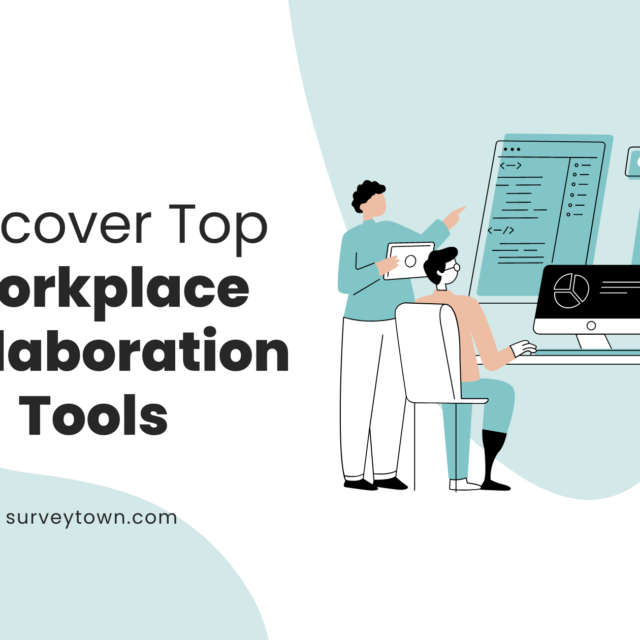Welcome to Survey Town, your ultimate destination for mastering the art of microsurveys! In this section, we’ll show you how microsurveys revolutionize data collection. Microsurveys gather valuable insights swiftly and effectively by asking a limited number of targeted questions. Respondents can complete these surveys in minutes. Microsurveys have taken the data collection world by storm due to their remarkable advantages:
- Save time: With their streamlined format, microsurveys appeal to busy individuals who don’t have the patience for lengthy questionnaires.
- Boost response rates: Shorter surveys are less burdensome, increasing active participation.
- Real-time insights: Rapid response collection allows quick analysis and informed decision-making.
- Laser-focused precision: Microsurveys provide specific insights without overwhelming participants with irrelevant queries.
- Enhanced user experience: Designed with user experience as a top priority, microsurvey layouts minimize fatigue while capturing invaluable data.
Embrace microsurvey methodology for efficiently targeted feedback and an exceptional user experience. Let’s dive into the captivating world of different microsurvey types in Section 2!
Types of Microsurveys: A Comprehensive Guide
Welcome to our expert guide on creating microsurveys, a powerful tool for gathering valuable insights. In this comprehensive guide, we will explore different types of microsurveys and provide real-life examples and use cases for each one.
First, we have multiple-choice surveys. These surveys present predefined answer options and excel at collecting quantitative data. For example, you can ask questions like “Which product feature do you find most useful?” or “How likely are you to recommend our service?”
Next up are rating scale surveys. With these surveys, respondents rate their opinions or experiences on a scale from 1 to 5 or 1 to 10. They offer more nuanced feedback compared to multiple-choice questions and effectively measure satisfaction levels. You might ask questions such as “On a scale of 1-10, how satisfied are you with our customer support?” or “Rate your experience at our recent event.”
Open-ended surveys give respondents the freedom to express their thoughts without predefined answer options. These qualitative surveys uncover valuable insights directly from the customers themselves. Consider asking questions like “What improvements would you like us to make in our product?” or “Tell us about your favorite feature in our app.”
Likert scale surveys prompt respondents to indicate their level of agreement or disagreement with statements using a range (e.g., strongly agree, agree, neutral). They help gauge attitudes and opinions by measuring the intensity of agreement or disagreement. Examples include statements like “I feel valued as a customer” or “The user interface is intuitive and easy to navigate.”
Lastly, NPS surveys measure customer loyalty by asking how likely they are to recommend a product/service on a scale of 0-10. This helps identify promoters, passives, and detractors for valuable insights into overall satisfaction levels.
These examples represent just some of the microsurvey options available – each serving its purpose in collecting specific data points tailored towards your research goals. In the next section, we will delve into creating highly effective microsurveys and share expert tips and tricks for maximizing their impact. Stay tuned!

How To Create Effective Microsurveys: Step-by-Step Process
As an expert in the field, I will guide you through a step-by-step process to ensure your microsurveys are engaging, informative, and yield valuable insights. Let’s dive into how you can create effective microsurveys:
- Define Your Objectives: Clearly define what specific information you want to gather. Are you seeking customer feedback on a new product or trying to understand user preferences? Defining your objectives shapes your survey.
- Choose the Right Type of Microsurvey: Consider factors like market research, consumer feedback, or product evaluation when selecting the most appropriate type that aligns with your goals.
- Keep it Short and Focused: Participants complete shorter surveys more willingly than lengthy ones. Ensure each question contributes directly to achieving your objectives while keeping them concise.
- Use Clear Language: Craft survey questions using language participants can easily understand. Avoid jargon unless necessary for specific target audiences.
- Utilize Multiple Choice Questions (MCQs): MCQs provide predefined options for quick and accurate responses without much effort required from participants.
- Include Open-Ended Questions Sparingly: While multiple-choice questions efficiently gather quantitative data, sparingly include open-ended questions for participants to express their thoughts fully.
- Design an Engaging Layout: Create a clean and intuitive design with consistent branding elements for a seamless experience.
- Test Your Survey: Thoroughly test before launching it – check for errors or inconsistencies in the questions, logical flow, and functioning response options.
- Consider Mobile Compatibility: Optimize surveys for mobile devices as smartphone usage continues to rise – ensure responsive layouts on smaller screens.
- Pilot Testing: Conduct pilot tests with a small group of participants to identify potential issues or areas for improvement before distributing widely – gather feedback regarding question clarity and overall user experience.
- Distribute Your Microsurvey Strategically: Determine how best to distribute based on where your audience is most likely to engage – email invitations, social media platforms, website pop-ups, or embedding surveys within mobile apps.
- Track Response Rates: Monitor participation levels and make adjustments if necessary – send reminders or offer incentives to encourage completion.
- Analyze Results: Utilize statistical analysis tools to gain insights into trends, patterns, and correlations within the dataset.
- Take Action Based on Insights: Identify key findings and develop strategies accordingly.
By following these expert steps, you can create microsurveys that drive data-driven decision-making. Remember always evaluate and refine based on feedback.
Choosing the Right Type of Microsurvey for Your Needs
Choosing the right microsurvey type is essential for effective data collection. As an expert in this field, I’ll guide you through the decision-making process with these important factors:
- Define your goals: Clearly define what information you want to collect and why. Are you seeking customer feedback or understanding market trends? Knowing your objectives upfront helps you make an informed choice.
- Consider your audience: Different microsurveys cater better to certain demographics or industries. Use app-based surveys for tech-savvy individuals and phone/email surveys for older adults who prefer traditional methods.
- Assess time constraints: If immediate results are crucial, use SMS surveys that reach participants instantly.
- Evaluate budget limitations: Determine how much you’re willing to invest and choose a type that aligns with your budgetary constraints.
- Explore available resources: Enhance effectiveness by using existing tools designed specifically for market research surveys or gathering customer feedback.
- Seek expert advice if needed: Consult professionals such as market research firms or software providers specializing in survey solutions if uncertain about which microsurvey type suits your needs best.
By considering these factors alongside your data collection goals, confidently select the perfect microsurvey type that provides valuable insights and empowers informed decisions. Remember, choosing the appropriate microsurvey type maximizes response rates and obtains accurate data. In the next section, we’ll delve into strategies to enhance response rates in microsurveys further!
Maximizing Response Rates: Best Practices
Want accurate and insightful data? Then listen up! As an expert in the field, I’ll share some game-changing practices to boost your response rates and gather valuable feedback through microsurveys.
- Personalize Your Invitations: Engage respondents by addressing them by name and tailoring survey invitations based on their preferences or past interactions. Show them they’re valued, increasing their willingness to participate.
- Offer Incentives: Motivate participants with discounts, gift cards, or exclusive content as rewards for completing your microsurvey. It’s a win-win situation where both parties benefit – higher response rates plus increased participant satisfaction.
- Use Multiple Channels: Reach a wider audience by distributing your microsurvey invitations across various channels – email campaigns, social media platforms, website pop-ups, and even SMS messages! Diversify distribution channels to capture the attention of more potential participants.
- Follow Up (but don’t spam): Gentle reminders significantly boost response rates as people may forget about the survey invitation altogether! Strike a balance between reminding and overwhelming participants with excessive follow-up emails that could discourage them from participating at all.
- Test and Optimize: Continuously improve by conducting A/B testing on subject lines, email copy, or survey design elements to find what resonates best with your target audience. Use the insights gained to optimize future surveys for better engagement and higher response rates.
By implementing these expert tips, you’ll significantly increase response rates and gather valuable data that drives informed decision-making within your organization.
Analyzing and Interpreting Microsurvey Data: Expert Insights
First, cleanse and organize your data by removing duplicates and irrelevant responses. Then, identify key metrics like response rates and average ratings to understand customer preferences. Visualize your findings with charts or infographics for easy understanding. Dive deep into patterns and trends across different questions or demographics. Benchmark against industry standards for context.
Don’t forget qualitative feedback from open-ended questions – it offers a deeper understanding of customers’ thoughts. Let the data drive your decision-making process for product improvement, marketing strategies, or customer service enhancements. Continuously iterate and refine based on real-time feedback. If you need assistance, consult market research professionals who specialize in survey analysis. Analyzing microsurvey data unlocks valuable knowledge about your customers!
Case Study: Successful Implementation of Microsurveys
Discover the power of microsurveys through real-life success stories. Learn from industry leaders who have expertly implemented different types of microsurveys. Gain valuable insights and key takeaways to apply to your own projects.
Case Study 1: A renowned market research firm gathered feedback from clients on their services. They used an online survey platform to distribute a concise yet impactful microsurvey via email. The questions covered satisfaction levels, areas for improvement, and suggestions for enhancements. With an impressive response rate, they identified strengths and growth opportunities.
Case Study 2: A leading software company gained deep insights into user preferences by integrating in-app microsurveys seamlessly. Strategically timed pop-up surveys collected real-time feedback without disrupting the user experience. This empowered informed decisions on product updates.
Case Study 3: A prominent consumer goods manufacturer understood customer satisfaction levels using a multi-channel approach combining paper-based questionnaires with QR codes leading respondents to an online survey. By offering various participation channels tailored to diverse customers’ preferences, maximum reach, and participation were ensured.
These case studies exemplify the versatility and effectiveness of microsurveys in gathering valuable insights from customers, clients, and users across different industries. Embrace the power of microsurveys to unlock actionable data that drives decision-making forward in market research, software development enhancement, or measuring customer satisfaction.




